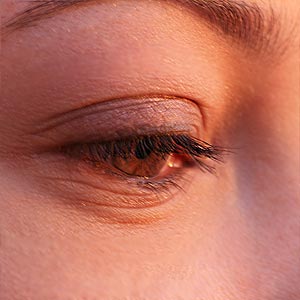Natural Sunblock

Sun blocks are used to block the UV rays of the sun from penetrating the skin. The metallic material in the sun block reflects and scatters the UVB rays thus shielding people with sensitive skin.
Zinc oxide and titanium dioxide form the main ingredients of sun blocks. These ingredients protect the skin from UVB and UVA rays. Sun block is not absorbed completely into the skin; it remains on the surface. Homemade natural sun blocks are an option to consider as against chemically loaded ones available in stores. Natural sun blocks can be used by people with sensitive skin too.
Many people do not prefer sun block as it opaque and can get quite messy. Sun block lotions tend to stain clothes. They are not absorbed into the skin and are likely to show.
Natural sun block recipe
Pick a bottle of your favorite natural lotion, one without citrus oils. Add a couple of tablespoons of zinc oxide. Take care that you do not inhale the zinc oxide. Mix ingredients.
Oil based sun block
Coconut oil 1/3 cup
Zinc oxide 5 tsp
Vitamin E oil 2 capsules
Beeswax 1 tbsp. (for thicker consistency you may use more quantity)
Distilled water ½ cup
Natural aloe Vera gel 3 tbsp., use alcohol free gel
Essential oils that are not citrus oils can be used to improve the fragrance of the sun block. Mix ingredients well.
Cocoa butter sun block
Use a double boiler to melt and mix sesame oil, cocoa butter and bees wax. Stir with a spoon until the mixture reaches a smooth consistency. Remove the double boiler from heat and add the distilled water to the mixture. Break open the Vitamin E capsules; add the oil to the mixture. Add the zinc oxide and rosemary tincture to the mixture until thoroughly blended. Allow the sun block recipe to cool before transferring it to a storage container with a lid. Store the homemade natural sun block in the refrigerator.
|
Sun block
|
Sunscreen
|
|
Reflects and scatters the sun's rays and thus blocks the sun from the skin |
Protects the skin by absorbing the sun rays |
|
Physical sunscreen, application is not absorbed into the skin |
Chemical sunscreen, application is absorbed into the skin |
|
Offers protection from UVA and UVB |
Offers protection from UVB only |
|
Not too many chemicals |
Loaded with chemicals |
|
Suitable for sensitive skin |
Not suitable for sensitive skin |
|
Complete care for protection against sun |
Best product to protect from sun burn |
|
Opaque and messy |
Light and easy to use |
|
Active ingredients are Titanium dioxide, zinc oxide |
Active ingredients are Octylcrylene Avobenzone, Octinoxate, Octisalate Oxybenzone, Homosalate, 4-MBC Mexoryl SX and XL, Tinosorb S and M, Uvinul T 150, Uvinul A Plus |
|
Safe to use and no free radicals |
Safe, however the chemicals may produce free radicals that may advance aging of the skin |
Waterproof sun block
If you are an avid swimmer, waterproof sun blocks are your choice during summer. Waterproof sun blocks are available as fine body mist, lotions, creams, sprays, etc..
- These sun blocks are water proof and sweat proof.
- Long lasting and prevents radical damage.
- Ideal for everyday sun protection, particularly for people spending considerable time in the water and for people who sweat a lot.
Water-resistant sun block maintains the SPF level after 40 minutes of water immersion. Very Water-resistant sun block maintains the SPF level after 80 minutes of water immersion. Based on the usage and time spent in water, pick a product suitable for you.
Sunblock for hair
It's just not the skin but also the hair that gets affected by the harsh rays of the sun. As we protect the skin from the sun, so also we must protect the hair from harsh rays of the sun. The UV radiation can make the hair dry, rough, greasy and can even cause split ends.
Sun blocks protect the hair cuticle, the upper most layer of the hair. They form a coat and do not allow the sun rays to penetrate deep into the hair layers. The coat reflects the sunlight and heat instead of absorbing it. They repel the radiation. Titanium dioxide and zinc oxide are commonly used in sun blocks.
Sun blocks for the hair are available as creams, sprays, etc. Massage the creams onto the hair or spray them on. While picking a sun block for the hair, remember:
- To pick a sun block that is for the hair and not just for the scalp.
- Pick sun block that is less oily so as to prevent greasiness of the hair.
- Pick sun blocks that are alcohol free and residue free. Alcohol can dry up the hair and thus make it brittle. Residue in the hair can ruin your hair.
Sun block SPF
SPF means Sun Protection Factor of sun block or sunscreen. The SPF numbers, multiplied by 10, indicate the number of minutes that the Sun Block will offer protection against the sun rays. SPF is a measure of a sun block's ability to prevent UVB from damaging the skin.
- Sun blocks with an SPF of 15 or higher offer excellent protection against UVB.
- SPF 15 filters out 93% of UVB, SPF 30 filters 97% and SPF 50 filters 98%. Higher the SPF, higher the protection.
- Zinc oxide and titanium dioxide are active ingredients that work against UVA.
In general no sun block offers complete protection and cover against the harsh rays of the sun. It is advisable to reapply sun block every two hours. Sun blocks are not just for the sunny days. You need sun protection even on cloudy days or in the cold. In fact, snow reflects UV rays. Apply the sunblock to all exposed areas of your skin. You need to apply the sunblock about 20 minutes before venturing out in the sun.
Top of the Page: Natural Sunblock
Tags:#natural sunblock #sunblock vs sunscreen #waterproof sunblock #sunblock for hair #sunblock products #sunblock spf
 Beauty
Beauty Facial Skin Care
Skin Care Essentials
Men's Skin Care
Beauty Control - Sunscreen
Sunburn Remedies
Natural Sunblock
Beauty Care Routine
Skincare Tips for Teens
Dry Skin Care
Asian Skin Care
Black Skin Care
Pregnancy Skin Care Tips
Oily Skin Care
Skincare For Aging Skin
Common Skin Problems
 Crow's Feet
Crow's Feet Hyperpigmentation
Melasma
Acne during Pregnancy
Back and Chest Acne
Adult Acne in Women
Excessive Sweating
Whiteheads
Cause Dark Eye Circle
Chapped Lips
Age Spot
Skin Cancer Symptom
Skin Care Treatments
 Chemical Skin Peels
Chemical Skin Peels Radio Frequency Skin Tightening
Electroporation Beauty Treatment
Home Remedies for Large Pores
Dermaplaning Benefits
Manuka Oil Benefits
Skin Needling
Cheek Fillers
Cosmetic Dermal Filler
Skin Lightening
Skin Exfoliation
Bamboo Massage
Dry Skin Brushing
Stretch Mark Removal
Freckle Removal
Rosacea Treatment
Skin Care Routine
Tretinoin Cream Benefits
Alpha Hydroxy Acid
Homemade Face Mask
Bath Salt Recipe
Tea Tree Oil
Wrinkle Cream
Almond oil Benefits
Jojoba Oil
Handmade Soap
Eye Creams
Facial Cleanser
Botox Cosmetic
Benefit of Aloe Vera
Shea Butter Benefit
Top of the Page: Natural Sunblock
Popularity Index: 101,401

